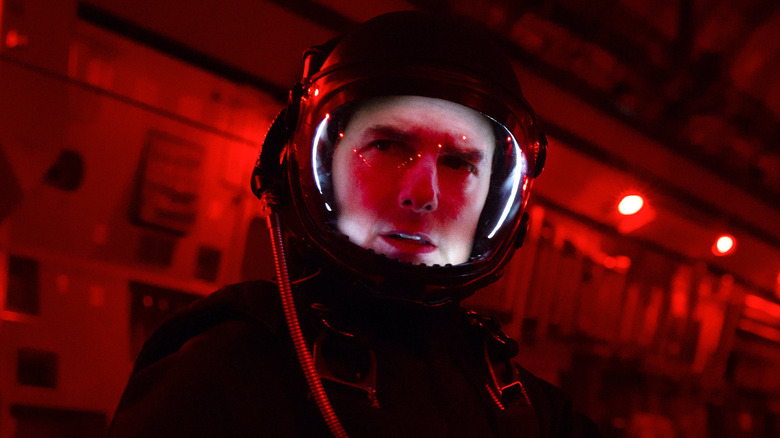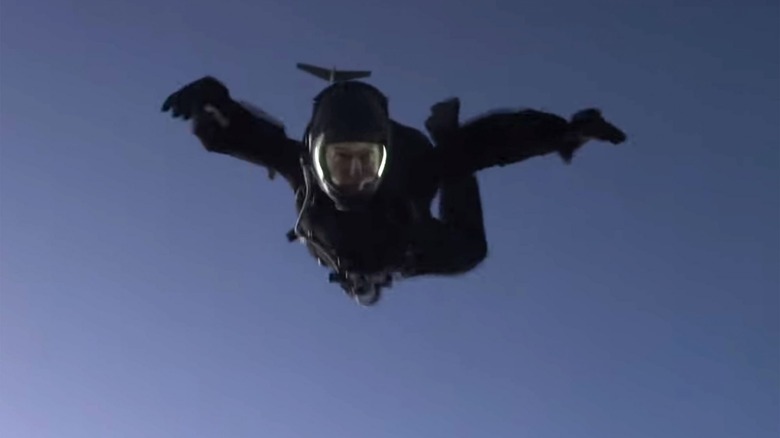One Mission: Impossible – Fallout Prop Meant The Difference Between Life And Death
The "Mission: Impossible" series is known for its death-defying stunts. In "Mission: Impossible — Fallout," Tom Cruise does a HALO (High Altitude Low Open) jump — a military technique in which a skydiver jumps from an incredibly high altitude and deploys their parachute at the last minute from a very low altitude.
Tom Cruise, director Christopher McQuarrie, and the filmmaking team had to practice the jump 106 times to perfectly synchronize the physical and visual choreography. "It was so important for me to get it right because I want to put the audience right there in that moment, feeling this sense of danger as Ethan has to improvise when everything goes wrong," Cruise told Yahoo!. McQuarrie expanded on that idea in an interview with /Film:
"How do we make it subjective? How do we put the audience with Ethan? I'd seen plenty of people jump out of planes, but always with the camera on their backs. I had to devise a way to 'pull' Tom from the plane rather than 'push' him."
The use of a skydiver with a camera strapped to his helmet really immerses the audience in the high-adrenaline act. It creates a truly breathtaking shot when Cruise run towards the cameraman to jump off the C-17 military transport aircraft, and the doorway disappears before he's swallowed up by the massive sky.
The HALO jump is a thrilling scene that feels tangible because we actually follow Cruise as he plummets toward Earth at 25,000 feet and 225 miles per hour. McQuarrie also sustains the tension and excitement by having the action unfold in only three separate shots. As with any "Mission: Impossible" stunt, the jump came with a high amount of risk, and the filmmakers had to design a prop that also functioned as a life-saving device.
A special helmet made it possible
The main danger of the HALO jump is the risk of hypoxia, which is when oxygen levels in the blood are lower than normal. In a behind-the-scenes video, one of the stunt performers, Ray Armstrong, explains that at such high altitudes, "You start losing your mind, but you don't realize it. You're not getting the oxygen to your brain, so you're making what you think are sound decisions, and they're not." Therefore, the actors needed a constant flow of oxygen. That's where the special prop came in.
Action props supervisor Toby Shears says they had to turn the helmets into an "oxygen delivery system" while also shining a light on the actors' faces since the skydivers usually wear black, obscuring headgear. The audience needed to see Tom Cruise's expressions during the intense free fall while he's saving August Walker (Henry Cavill) after Walker is struck by lightning. The team ended up using LED strip lighting so any spark wouldn't set the actors on fire. Taking extra measures for safety, Tom Cruise says the helmet was "rated with the Royal Airforce. They took it to a hyperbaric chamber just to test it," and Armstrong confirms it was tested "until it was deemed beyond its safe working height."
The HALO jump in "Mission: Impossible — Fallout" is a stunning sequence that demonstrates the filmmakers' dedication to realism and high-stakes action. The story of this small but significant prop — a helmet which allows actors to breathe while performing one of the most intense stunts ever — reminds us just how much dedication and care the filmmakers put into the adrenaline-pumping set pieces that make the series so beloved.

